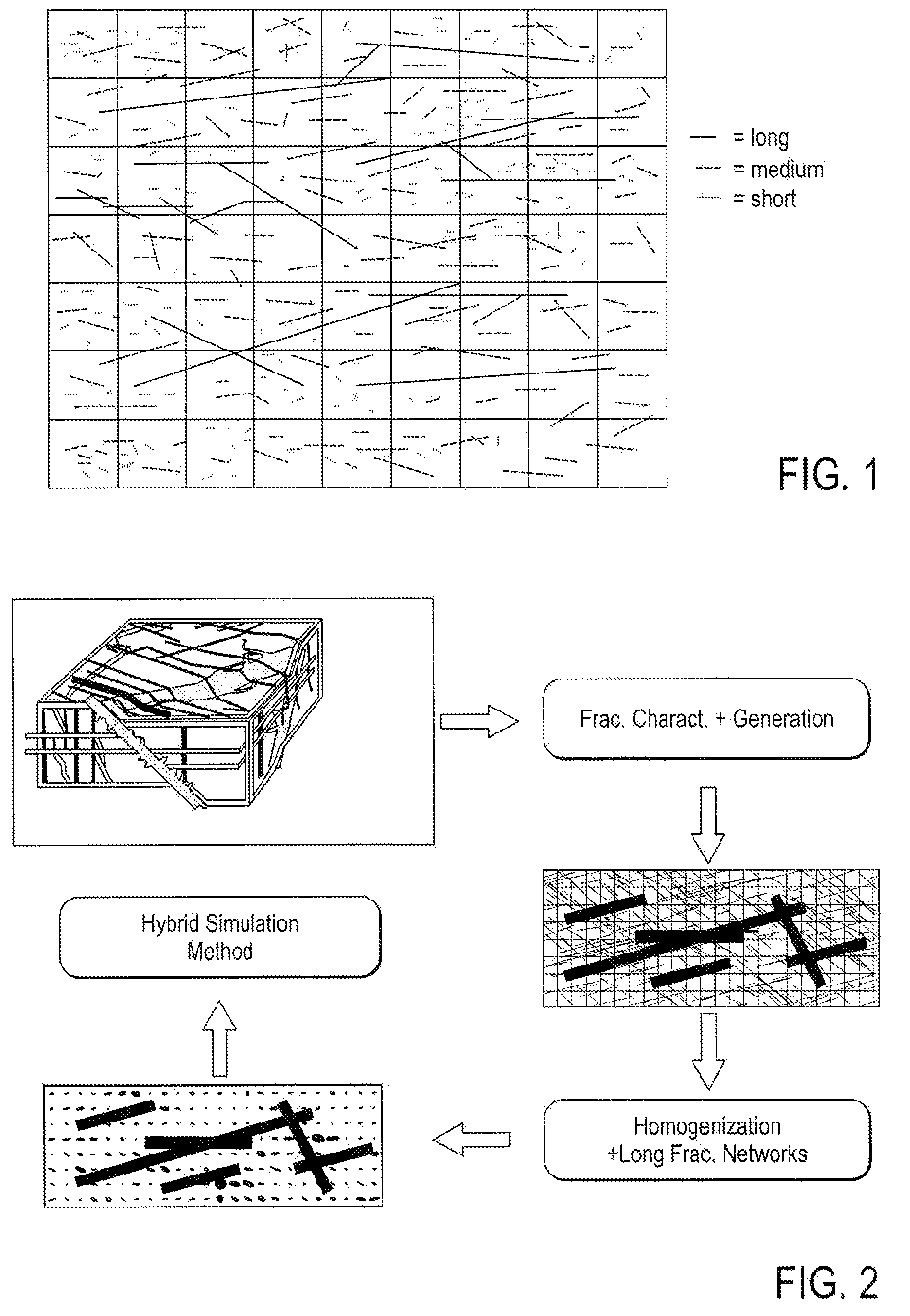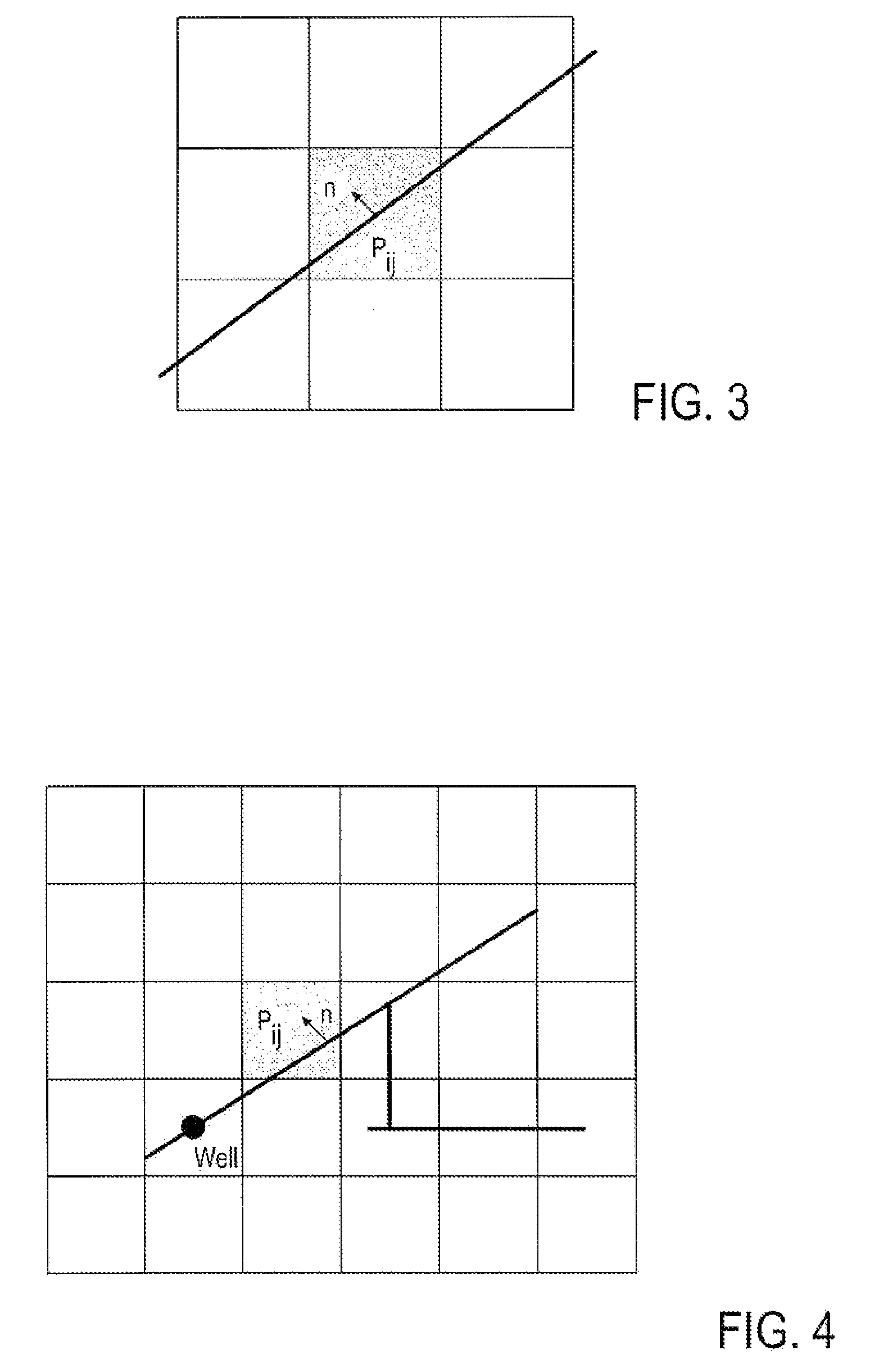Method, system and apparatus for simulating fluid flow in a fractured reservoir utilizing a combination of discrete fracture networks and homogenization of small fractures
a reservoir and fluid flow technology, applied in the field of fluid flow simulation in naturally fractured reservoirs, can solve the problems of high computational cost, inflexible capturing or honoring fracture characteristics in real reservoirs, and high computational cost of dual porosity/permeability methods, so as to enhance numerical stability and enhance numerical stability in solving flow equations.
- Summary
- Abstract
- Description
- Claims
- Application Information
AI Technical Summary
Benefits of technology
Problems solved by technology
Method used
Image
Examples
example 1
Single Long Fracture Model
[0126]In a first example, a quarter of five-spot configuration is examined, in which the flow is driven by a source and a sink placed at the opposite corners of a three-dimensional domain. The model has dimensions of 500 ft×500 ft×9.9 ft, discretized equally by 20×20 grid blocks horizontally and 3 blocks vertically. This results in 1200 regular grid blocks with each block of dimension 25 ft×25 ft×3.3 ft. The short and medium fractures are generated from a stochastic process and are shown in FIG. 6 for Layers 1, 2, and 3. The areal or top view of the second layer of the model is shown in FIG. 7.
[0127]In FIG. 7, a long fracture is included which extends from cell (6, 6) to cell (15, 15), in the second layer to demonstrate how to model a long fracture as a major fluid conduit. The matrix permeability is km−1 md and the fracture permeability is kf=1000 Darcy and the transport index is TIi=4270 ft3 / day ft.
[0128]Following the hierarchical framework, the effective...
example 2
A Network with Three Connected Long Fractures
[0131]Based on the settings in the previous example, two other long fractures are added, from cell (6, 10) to cell (15, 10), and from cell (14, 14) to cell (14, 18), to connect the original long fracture and form a small fracture network, shown in FIG. 10. The fracture permeabilities in these newly added long fractures are the same as the previous one, as are the transport indices.
[0132]FIGS. 11 and 12 are water saturation maps of the second layer in the heterogeneous and homogeneous systems with a network of long fractures at t=0.254 PVI. These maps confirm that the present method of numerical simulation captures the phenomena described in the previous example. As expected, the fracture network picks up the displacing fluid from upstream ends and transport from the connected fractures to form multiple fronts in the downstream. The enhanced matrix permeability due the presence of small / medium fractures increases fluid transport in matrix,...
example 3
A Network of Long Fractures Intersecting an Injection Well
[0133]In the following three examples, a reservoir model is constructed which is 5000 ft×5000 ft×300 ft. in dimension. The top of the reservoir is 8325 feet deep and the model is discretized uniformly by 10×10 grid blocks in the horizontal plane and by 3 matrix blocks in the vertical cross-section. The initial oil saturation is assumed to be 1 in the whole domain. A quarter of a five spot pattern is applied in this bounded three-dimensional example. FIG. 13 shows the grids of the model and the locations of the injection well (1, 1, 3) and production well (10, 10, 1). Gas is injected at a constant rate, 10000 MSCF / day, and the bottom hole pressure of the producer is maintained at 4000 psi. The matrix permeabilities and porosities used in these examples are listed in Table 1.
[0134]In this example, two long, intersected fractures are included that cut through all three layers, as shown in FIG. 13. Note that all fractures are ass...
PUM
 Login to View More
Login to View More Abstract
Description
Claims
Application Information
 Login to View More
Login to View More - R&D
- Intellectual Property
- Life Sciences
- Materials
- Tech Scout
- Unparalleled Data Quality
- Higher Quality Content
- 60% Fewer Hallucinations
Browse by: Latest US Patents, China's latest patents, Technical Efficacy Thesaurus, Application Domain, Technology Topic, Popular Technical Reports.
© 2025 PatSnap. All rights reserved.Legal|Privacy policy|Modern Slavery Act Transparency Statement|Sitemap|About US| Contact US: help@patsnap.com



